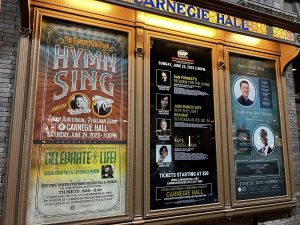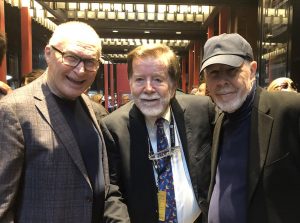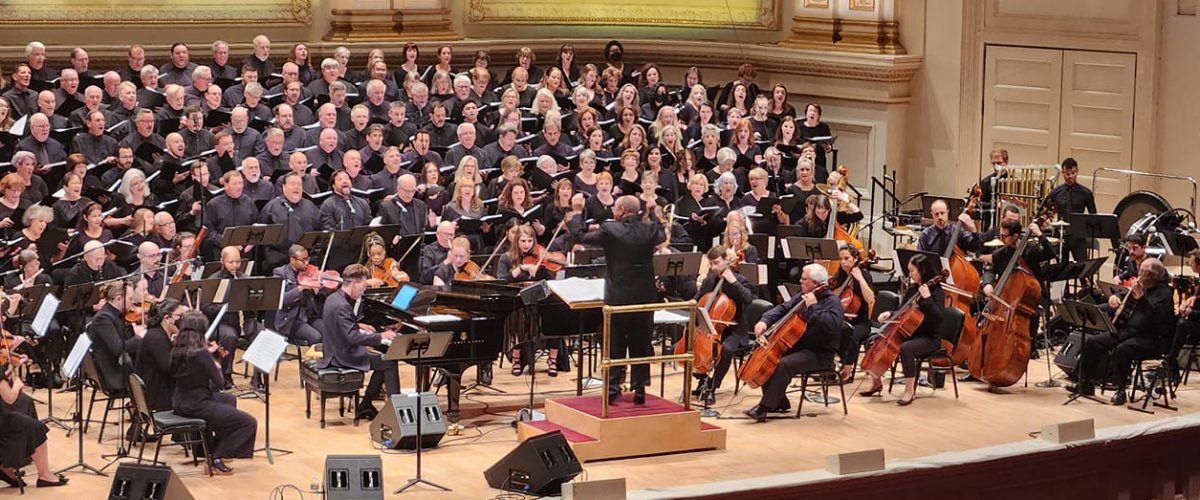Thematic use of a minor 7th chord is one of the secrets to the enduring success of the 1970s-era youth musical Celebrate Life, according to a musician who helped facilitate a Carnegie Hall revival this summer.
In musical terms, a minor 7th is perhaps best known from the opening of the Star Trek theme — bah-bah, dah-dah-dah-dah — or from “Somewhere” in West Side Story — “There’s a place for us.”
That musical sequence appears from beginning to end in Celebrate Life, said Tim Sharp, former executive director of the American Choral Directors Association.
 For example, one of the youth musical’s best-known songs, “In Remembrance,” urges Christians not to look for Jesus above “but in” your heart — a minor 7th. And “The Truth Shall Make You Free” begins with a minor 7th — “He’s the wind I soar on.”
For example, one of the youth musical’s best-known songs, “In Remembrance,” urges Christians not to look for Jesus above “but in” your heart — a minor 7th. And “The Truth Shall Make You Free” begins with a minor 7th — “He’s the wind I soar on.”
From the “Prelude” forward, the music of Buryl Red makes this haunting musical motif a central character of the biblical drama that became the soundtrack of several generations of church youth, particularly Baby Boomers.
“The use of the minor 7th interval as an organizing leitmotiv could not have been more economical or theological,” Sharp said. “Red introduced this organizing theme in the ‘Prelude’ and built most of the work around it. … The breadth of the minor 7th interval captured the larger theme of this work, the breadth of God’s love and a peace that goes beyond understanding.”
“Peace” is, in fact, the most repeated word in Celebrate Life, he added. “We find it in about every other movement and at the heart of the message. In ‘I Quietly Turned to You,’ the golden-mean moment comes when the Samaritan woman sings ‘Now I know such perfect peace.’”
Sharp not only has sung and conducted the work repeatedly, he has researched it history. Red, the composer, died in 2013. Ragan Courtney, the librettist, lives in Santa Fe with his wife, recording artist Cynthia Clawson, who got her national debut as a college student singing in Celebrate Life.
“I feel certain the first movement written was ‘Prayer for Peace,’ written a year before the rest of the work for a Christmas event at the United Nations,” Sharp said. “I believe Buryl Red knew he was in a ‘moment’ and put his most creative mind and skills to the task of creating Celebrate Life. In the end, I am certain it is the timeless message of the work, brilliantly crafted by Ragan Courtney from the Gospels, and Buryl Red’s genius that guaranteed the staying power of Celebrate Life.”
That staying power was on display June 24 when hundreds of people filled New York’s Carnegie Hall for a 50th anniversary performance with a 175-voice choir and full orchestra. Singers paid their own way to get to New York and to participate in the event.
One of those in the audience was retired Baptist minister Michael Chance, who lives in New Jersey.
“From the opening notes, the words to those songs I’d sung 43 years ago came roaring back into my mind.”
“From the opening notes, the words to those songs I’d sung 43 years ago came roaring back into my mind,” he said. “I wept at times through the presentation. I sang along to every musical number. The ‘He Is Alive’ chorus near the end of the presentation brought goose bumps down my spine. It was a night of worship, indeed. My Tier 1 ticket put me near the front, overlooking the orchestra and choir. I was mesmerized.”
Chance first heard Celebrate Life in 1973 at First Baptist Church of New Orleans.
The performance “knocked my socks off,” he said, “especially the characterization of Matthew the disciple by FBNO Youth Pastor Dick Stafford.” That inspired Chance, seven years later, to jump at the opportunity to portray Matthew at the Ivy Memorial Baptist Church in Hampton, Va.
That 1980 event “was the first major musical presentation of that caliber ever performed at Ivy Memorial Baptist Church,” he explained.

Michael Chance (left) with Ragan Courtney and Peter Link outside Carnegie Hall.
Celebrate Life so influenced his own life and ministry that one of his lifelong dreams was to meet Ragan Courtney. He had tried several times before but it didn’t work out. This night, as the Carnegie Hall ushers shooed everyone out of the theater, Chance found himself on the sidewalk on 57th Street and saw Courtney also exit the theater. He introduced himself, and they talked about several mutual friends, then took a photo together.
“It was like two long-lost friends meeting up after not seeing one another for decades,” Chance said. “Just like Ragan, I, too, am a native of North Louisiana, and just like Ragan, our spiritual journeys have matched up quite similarly in more recent years. … I was so ‘pumped’ that my walk from West 57th Street back down to Penn Station was a breeze.”
Such is the appeal of the most enduring church-based youth musical of all time. For anyone raised in a Southern Baptist church in the 1970s and ’80s, Celebrate Life was omnipresent. Some youth choirs performed it year after year, took it on mission tours and committed it to memory.
Bill Choate, who works with the Tennessee Baptist Mission Board, was one of those youth. He also made the journey to New York for the anniversary concert.
“Celebrate Life was a transformative event for so many in our generation.”
“Celebrate Life was a transformative event for so many in our generation,” he said. “It came at a time when graded choir programs were the strongest ever. Youth choirs across North America were musically capable of doing substantive musical works. They were waiting for this musical to be created.”
Further, “The music itself was of such high quality it won the attention of traditionally trained church musicians of the day. I performed this work in the ’70s under the direction of my father, our church musician, trained in the late 1950s on organ at Southwestern Baptist Theological Seminary. His respect for the high-quality composition allowed him to cross the bridge to this more modern form.”
That was true not only of Buryl Red, who was a respected composer and music educator, but also of Ragan Courtney, who had legitimate theatrical chops. Together, they told the life and ministry of Jesus in a way Jesus Christ Superstar couldn’t, but with a percussive folk music beat that felt like it came right off Broadway.

Tim Sharp
Sharp also was shaped by Celebrate Life as a teenager.
“The excitement of the music of Celebrate Life as composed by Buryl Red, and the gospel story as narrated through the craft of playwright Ragan Courtney, were foundational to my early work in church music,” he said. “I was a student at Belmont University when the work was published and premiered, and it was one of the most exciting things that had been created during that era of my church music preparation. I performed the work as a teenager, conducted the work several times early in my career, and then at the 25th anniversary celebration, Ragan Courtney invited me to play the part of John.
“It was a joy to be on stage with Ragan, Cynthia Clawson and many other enthusiastic fans of the work at the Baptist assembly at Ridgecrest and Glorieta for this 25th anniversary celebration, which also featured the new orchestration by Bruce Greer.”
Greer, a Texas-based composer and arranger, played a key role in making the 50th anniversary Carnegie Hall event happen. Greer worked with Roy Hayes and Truth North Productions to stage the work at Carnegie Hall.
They linked it to “The Great New York Hymn Sing” featuring the vocal ensemble Selah and full orchestra.
Sharp conducted the Carnegie Hall performance.
“I believe it is not only an important work, but it is a solid composition.”
“I was thrilled since this piece has been so important to me,” he said. “In addition, I believe it is not only an important work, but it is a solid composition.”
He spent a full year not only studying Greer’s musical arrangements but also interviewing everyone he could find who was part of the original composition, production and recording. “The insights and anecdotes breathed an amazing amount of energy into the work for me as I headed toward America’s premiere concert stage.”
The New York anniversary performance was nostalgic, to be sure, but it also proved Celebrate Life stands the test of time, Sharp explained. “What had not changed about Celebrate Life was its great message, the impact of the music and text on the performer and listener, and its relevance to life today.”
The choir gathered at Carnegie Hall “consisted of many worship leaders and ministers of music, so they all felt a sense of gratitude that this work had been a part of their early experience in the church,” he said. “This message has sustained our life and our careers, and we recognize this.”
Related articles:
‘Celebrate Life’ composer Buryl Red dies


